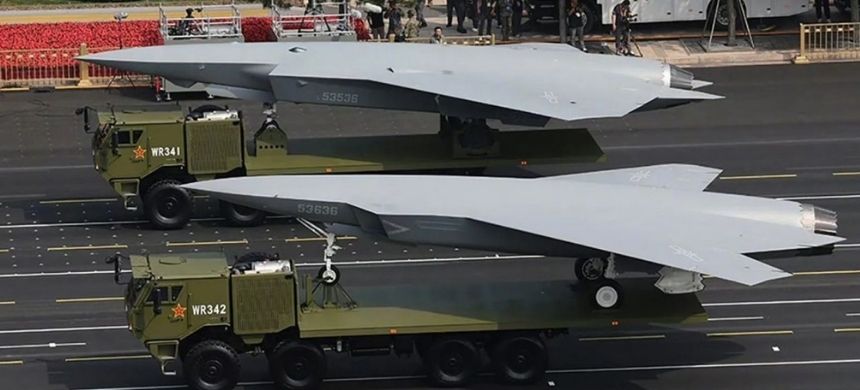China has unveiled a new, fighter-sized stealth drone during its recent military parade in Beijing, offering one of the clearest glimpses yet into the country’s rapidly advancing unmanned combat aircraft programs. The still-unnamed design, informally referred to as the Type B drone, suggests a focus on high performance — potentially including supersonic flight — alongside low observability, marking it as a true contender in the emerging category of uncrewed stealth fighters.
A Parade Debut with Strategic Significance
The drone was displayed on a flatbed truck during the September 3rd parade commemorating the 80th anniversary of China’s victory over Japan in World War II. Unlike smaller unmanned designs also presented at the event, the Type B stood out for its sheer size, appearing roughly equivalent to the J-10 medium-weight fighter. Its dimensions and advanced features point to an aircraft either close to flight testing or an exceptionally detailed mock-up, underscoring the seriousness of China’s intent in this field.
Although no official designation has been confirmed, speculation suggests a provisional name of Unmanned Air Superiority Fighter. Analysts have highlighted that, compared to other Chinese drones resembling U.S. Collaborative Combat Aircraft (CCA) concepts, the
Type B appears aimed at a higher-performance, more fighter-like role — a direction not currently pursued openly by the United States.
Design Characteristics
The Type B features a tailless configuration with a modified delta, diamond-shaped wing incorporating cropped tips and multiple control surfaces along the trailing edge. Its nose blends into forward-swept diverterless supersonic intakes (DSI) located on either side of the fuselage, pointing to supersonic capability. A single engine, likely equipped with afterburner, is mounted with a serrated, variable-geometry nozzle reminiscent of the F-35 and China’s newer fighter designs.
Additional elements such as trailing-edge extensions and stealth shaping suggest a careful balance between radar signature reduction and aerodynamic efficiency. While the exposed round engine nozzle diminishes stealth from the rear, its serrated construction helps reduce radar returns in certain bands. Future iterations could adopt a two-dimensional nozzle with thrust vectoring, paralleling developments seen on Russia’s S-70 Okhotnik and China’s own GJ-11 Sharp Sword.
The aircraft appears to include internal weapons bays beneath the fuselage, preserving low observability, as well as a prominent chin-mounted electro-optical sensor akin to the F-35’s Electro-Optical Targeting System (EOTS). Such features strongly suggest that the Type B is optimized for fighter-style missions rather than simply strike or reconnaissance roles.
The Smaller Type A Counterpart
Displayed alongside the Type B was another stealth drone, informally called the Type A. Slightly smaller and slimmer, this design incorporates a lambda-type wing and caret-style intakes. Unlike the Type B, it lacks the chin-mounted sensor but otherwise shares a similar single-turbofan powerplant. Its narrower profile indicates a different mission focus, though both drones bear serial markings linked to the People’s Liberation Army Air Force (PLAAF), raising questions about their developmental status.
Operational Uncertainty and Precedents
It remains unclear whether the Type A and B are flight-ready aircraft, advanced prototypes, or sophisticated mock-ups. Historically, China has used parades to showcase early-stage designs, some of which — like the GJ-11 UCAV — later matured into operational platforms. The detail level on both drones, including visible access panels, suggests they may be further along the development cycle than mere display models.
The GJ-11 itself has been refined since its debut, demonstrating strike, ISR, decoy- launching, and electronic warfare roles. By contrast, the Type B appears tailored for air-to- air combat, with potential for autonomous or semi-autonomous engagements, possibly in conjunction with manned fighters such as the twin-seat J-20, already envisioned as a drone controller platform.
China’s UCAV Ambitions vs. U.S. CCA Strategy
Unlike Western CCA concepts, which emphasize affordability, swarm employment, and cooperative tactics, the Type B reflects a different philosophy: a high-performance, stealthy
UCAV capable of independent operations. This distinction highlights China’s willingness to pursue costly, complex designs that could act as true unmanned fighters rather than expendable wingmen.
This divergence is particularly stark given that the U.S. Air Force has halted work on stealthy flying-wing UCAVs and remains focused on lower-cost collaborative platforms. China, by contrast, continues to expand its portfolio, with multiple stealth drone designs appearing in satellite imagery, flight testing, and parade displays.
A Growing Global Trend
China’s new drone concepts align with broader international efforts. Turkey’s Bayraktar Kizilelma, for example, also pursues a fighter-like unmanned role, with supersonic performance expected in later variants. However, Kizilelma’s canard-delta configuration and vertical stabilizers trade stealth for maneuverability, making it less radar-evading than China’s Type A and B.
Outlook
Whether the Type B ultimately becomes operational remains to be seen, but its emergence underscores a strategic shift toward uncrewed air combat dominance. If China succeeds in fielding such high-performance UCAVs, it could outpace the United States in this niche, potentially reshaping future airpower balances.
For now, the Type B represents a clear signal: Beijing is not only exploring unmanned combat aircraft for support and strike roles but is also positioning itself to develop true stealth fighters without pilots in the cockpit — a step that could redefine modern aerial warfare.











